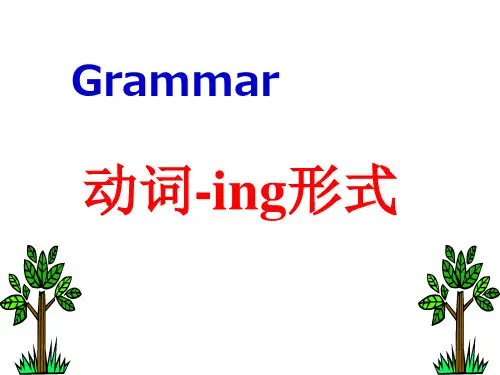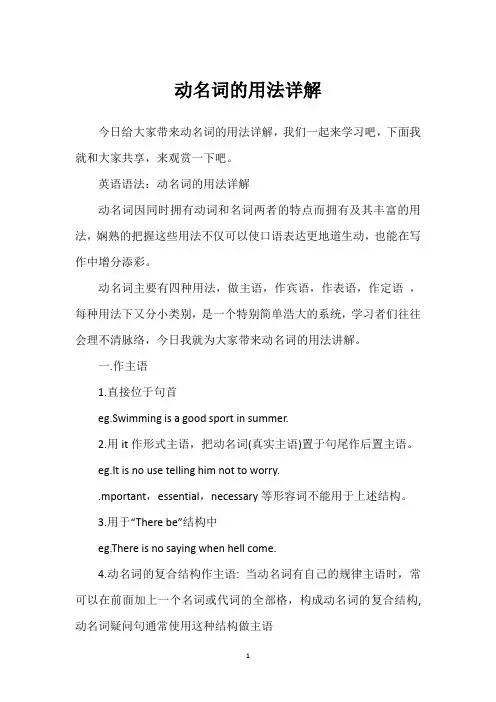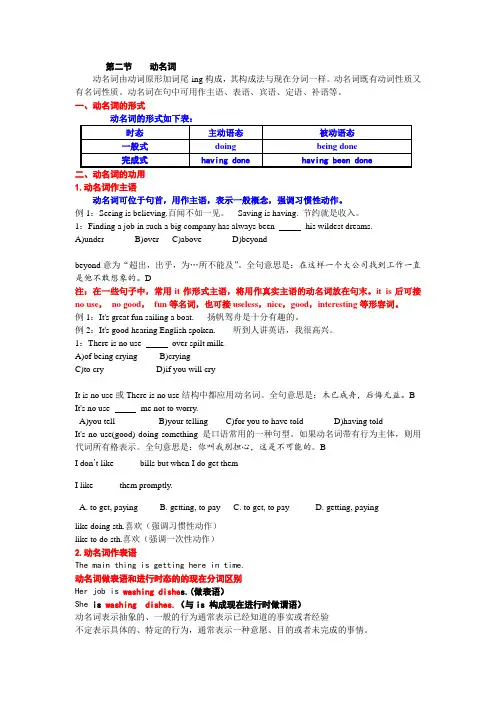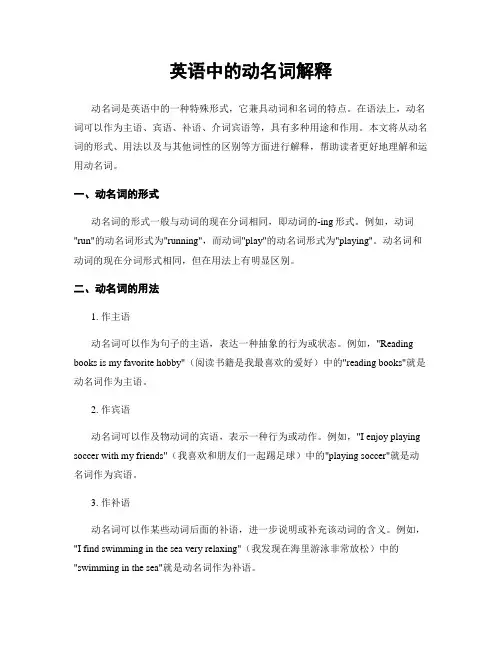精选最新大学英语四级语法精要:动名词的形式
动名词的构成形式

What I hate most is being laughed at. 我最痛恨的 就是被别人嘲笑。 (Being laughed at is what I hate most.)
动名词的几个注意事项
1)动名词的逻辑主语及复合结构 Would you mind _____(我开窗户吗)? Would you mind my / me opening the window? my/ me 称为动名词的逻辑主语. I can’t understand Jack /Jack’s leaving his wife. I can’t understand his/him leaving his wife. Jack’s/ His leaving his wife is unbelievable. 动名词的逻辑主语+ 动名词=动名词的复合结构
to do 动作尚未发生 1.remember/forget/ regret
doing 动作已经发生
to do 设法、努力去做,尽力 2. try
doing 试试去做(看有何结果)
to do 打算做(主语一般是人) 3. mean
动名词用法详细讲解解析

动词-ing形式
一. 含义
动词的-ing形式是非谓语动词的一种形式,不能单独充当 谓语。
二. 构成
1.构成: 动词原形+-ing 2.规则: ①一般情况,直接+ing; ②以不发音的e结尾,去e+ing;
③以重读闭音节结尾,末尾只有一个辅音字母的动词,双 写这个辅音字母再加ing;
④以ie结尾,变ie为y,+ing,例:die,dying;lie,lying.
1.It’s a waste of time thinking hard about the past.
2.The book is worth reading. 3.There is no harm in doing so.
2.以下动词须用doing 做宾语
Consider考虑 admit承认 practice实践 enjoy享受 mind介意 permit承诺
成分 主语
宾语
表语
定语
形式
动名词
√√
√√
现在分词 × × √
√
状语
宾补
×× √√
1.Reading in bed is bad for your eyes. ( _主_ 语)
2.She likes playing the piano . ( _宾_ 语)
3.As far as I know , his hobby is collecting stamps. ( _表_ 语)
考虑 完成 不耽搁 consider, finish, delay
喜欢 设想 不介意 fancy, enjoy, appreciate, imagine, mind
面对 坚持 不放弃 face, insist on, give up
动名词的用法详解

动名词的用法详解今日给大家带来动名词的用法详解,我们一起来学习吧,下面我就和大家共享,来观赏一下吧。
英语语法:动名词的用法详解动名词因同时拥有动词和名词两者的特点而拥有及其丰富的用法,娴熟的把握这些用法不仅可以使口语表达更地道生动,也能在写作中增分添彩。
动名词主要有四种用法,做主语,作宾语,作表语,作定语,每种用法下又分小类别,是一个特别简单浩大的系统,学习者们往往会理不清脉络,今日我就为大家带来动名词的用法讲解。
一.作主语1.直接位于句首eg.Swimming is a good sport in summer.2.用it作形式主语,把动名词(真实主语)置于句尾作后置主语。
eg.It is no use telling him not to worry..mportant,essential,necessary等形容词不能用于上述结构。
3.用于“There be”结构中eg.There is no saying when hell come.4.动名词的复合结构作主语: 当动名词有自己的规律主语时,常可以在前面加上一个名词或代词的全部格,构成动名词的复合结构,动名词疑问句通常使用这种结构做主语eg.Their coming to help was a great encouragement to us.Does your saying that mean anything to him?二.作宾语1.作动词的宾语某些动词后消失非限定性动词时只能用动名词作宾语,不能用不定式。
不定式通常指某种特定的动作,但动名词表示泛指,常见的此类动词有:admit,appreciate,excuse,stand,advise,allow,permit,avoid,consider,enjoy,f inish,give up,cannot help,imagine,include,keep,understand,keepon,mind,report,risk,miss,put off,delay,practise,resist,suggest,depend on,think about,set about,succeed in,worry about,burst out,insist on,feel like,be used to,get used to,devote…to…,look forward to,pay attention to,get down to,escape and so on.eg.They went on walking and never stopped talking.他们连续走,说个不停。
语法动名词分词解析

第二节动名词动名词由动词原形加词尾-ing构成,其构成法与现在分词一样。
动名词既有动词性质又有名词性质。
动名词在句中可用作主语、表语、宾语、定语、补语等。
一、动名词的形式动名词的形式如下表:二、动名词的功用1.动名词作主语动名词可位于句首,用作主语,表示一般概念,强调习惯性动作。
例1:Seeing is believing.百闻不如一见。
Saving is having. 节约就是收入。
1:Finding a job in such a big company has always been his wildest dreams.A)under B)over C)above D)beyondbeyond意为“超出,出乎,为…所不能及”。
全句意思是:在这样一个大公司找到工作一直是他不敢想象的。
D注:在一些句子中,常用it作形式主语,将用作真实主语的动名词放在句末。
it is后可接no use,no good,fun等名词,也可接useless,nice,good,interesting等形容词。
例1:It's great fun sailing a boat. 扬帆驾舟是十分有趣的。
例2:It's good hearing English spoken. 听到人讲英语,我很高兴。
1:There is no use over spilt milk.A)of being crying B)cryingC)to cry D)if you will cryIt is no use或There is no use结构中都应用动名词。
全句意思是:木已成舟,后悔无益。
B It's no use me not to worry.A)you tell B)your telling C)for you to have told D)having toldIt's no use(good) doing something 是口语常用的一种句型。
英语中的动名词解释

英语中的动名词解释动名词是英语中的一种特殊形式,它兼具动词和名词的特点。
在语法上,动名词可以作为主语、宾语、补语、介词宾语等,具有多种用途和作用。
本文将从动名词的形式、用法以及与其他词性的区别等方面进行解释,帮助读者更好地理解和运用动名词。
一、动名词的形式动名词的形式一般与动词的现在分词相同,即动词的-ing形式。
例如,动词"run"的动名词形式为"running",而动词"play"的动名词形式为"playing"。
动名词和动词的现在分词形式相同,但在用法上有明显区别。
二、动名词的用法1. 作主语动名词可以作为句子的主语,表达一种抽象的行为或状态。
例如,"Reading books is my favorite hobby"(阅读书籍是我最喜欢的爱好)中的"reading books"就是动名词作为主语。
2. 作宾语动名词可以作及物动词的宾语,表示一种行为或动作。
例如,"I enjoy playing soccer with my friends"(我喜欢和朋友们一起踢足球)中的"playing soccer"就是动名词作为宾语。
3. 作补语动名词可以作某些动词后面的补语,进一步说明或补充该动词的含义。
例如,"I find swimming in the sea very relaxing"(我发现在海里游泳非常放松)中的"swimming in the sea"就是动名词作为补语。
4. 作介词宾语有些介词后面需要使用动名词作为宾语。
例如,"I am interested in learning new languages"(我对学习新语言感兴趣)中的"learning new languages"就是动名词作为介词"in"的宾语。
英语四级常考的语法讲义知识点

英语四级常考的语法讲义知识点2009-06-30 15:23【加入收藏夹】四级语法讲义一:时态:所谓的"时态",就是时间+状态。
谓语动词的时态见下表:1.主动形式过去现在将来过去将来一般did do will/shall do should/would do进行was/were doing am/is/are doing will/shall be doing /完成had donehave/has done will/shall have done should/would have done用于虚拟语气完成进行had been doing have/has been doing / /2.被动形式过去现在将来过去将来一般was/were given am/is/are given will/shall be given should/would be given 进行was/were being given am/is/are being given / /完成had been given have/has been given will/shall have been givenshould/would have been given完成进行/ / /CET-4 常考的三种时态:过去完成时;将来完成时;(现在/过去)完成进行时。
v 时间状语从句当中的时态:一般过去时所有的过去用一般现在时表示现在和将来现在完成时现在完成和将来完成一.非谓语动词一.不定式:一)不定式的常考形式:1) 一般形式:He decided to work harder in order to catch up with the others.被动形式: He preferred to be assigned some heavier work to do.语法功能:表示与谓语动词同步发生2) 完成形式:He pretended not to have seen me.被动形式:The book is said to have been translated into many languages.语法功能:表示发生在谓语动词之前二)不定式常考的考点:1)不定式做定语----将要发生2)不定式做状语----目的3)不定式充当名词功能---To see is to believe.三)不定式的省略1)感官动词see, watch, observe, notice, look at, hear, listen to, smell, taste, feel+ do表示动作的完整性,真实性;+ doing 表示动作的连续性,进行性I saw him work in the garden yesterday.昨天我看见他在花园里干活了。
英语专业四级考试必考语法6-动名词
Gerund动名词非谓语动词•英语中,不作句子的谓语,而是用于担任其它语法功能的v ,叫非谓语动词,它不受主语人称、数等因素的限定,又被称作非限定动词。
•三大非谓语动词:动名词,分词和不定式。
动名词的语法功能•作主语•Seeing is believing.•Listening to music is one of my hobbies.•Studying abroad has many advantages.•Getting to know the world is what the future society requires of us.习惯用法• A. I t i s n o u s e/g o o d/h a r m+V i n g.It is no use quarreling with her.It’s no use crying over the spilt milk.• B. T h e r e i s n o+V i n g.There is no denying (the fact) that women are playing an important role in the world today.There is no joking about this matter. 这事开不得玩笑。
作表语•作表语•My favorite pastime is collecting stamps.•Her hobby is swimming and cycling.•One of the good virtues of a young person is being punctual.•My job is teaching.•One of the most difficult tasks you may encounter is learning a foreign language.作动词宾语•作动词宾语•She enjoys listening to rock music.•We appreciate your offering to help.•We must avoid making such mistakes again.•People who like travelling have their reasons.跟动名词作宾语的v.及v. phrase•常见的能跟动名词作宾语的v.及v. phrase:•admit, appreciate, avoid, confess to, consider, delay, deny, endure(忍耐), enjoy, escape, excuse, fancy(想象), finish, forbid, imagine, mind, miss, permit, postpone, practice, risk, can't help, feel like, give up, keep out, object to (反对), oppose, put off(推迟).•注意:动名词作宾语后面带有补语,一般不用形式宾语it。
动名词用法详解
2)动名词可以和一些介词如in, on, after, against, before, by, for, without, besides等构成短语, 在句中作状语。
❖ He left ahead of time without saying a word. ❖ 他一句话也没说就提前离开了。 ❖ Besides cooking and sewing, she had to take care of four
二.以不发音的e 结尾的 去e + -ing e – coming 来 2.dance - dancing 跳舞 3.close - closing 关 4.make – making 制造 5.ride – riding 骑 6.write - writing 写 7.take - taking 拿走 8.phone - phoning 打电话 9.dance-dancing跳舞 9.move – moving 移动 搬 10.have – having 有 11.leave-leaving 12.wake-waking
❖(拒绝, 否认) consi(de考r 虑)等。 。
❖ Msuamnympeer.op夏le季e,nj很oy多_人__s喜_u_n欢_b_在a_th_沙(ins滩ugn日b光at浴he。) on the beach in
❖ I suggest _____ (do) it in a different way. ❖ 我建议用另d一oi种ng方法做这件事。
动名词特点:
❖ 1、 动:它是从动词变化而来的,所以它保留了动词的某些特征 ------能带自己的宾语、状语等,这时叫动名词短语;
动名词的三种形式
动名词的三种形式动名词是英语语法中一种十分重要的形式,它可以用来表示动作的进行,同时也可以作为名词使用。
动名词的形式有三种,分别是基本形式、完成式和被动式,下面将对这三种形式进行详细介绍。
第一种形式为基本形式,这种形式在语法中也称为现在分词,它的构成是在动词后面加上 -ing,比如说 run 变成了 running。
在使用时,基本形式可以表示正在进行的动作,比如 The children are playing in the garden.(孩子们正在花园里玩耍。
)除此之外,基本形式还可以作为名词使用,例如 Swimming is good for your health.(游泳对健康有好处。
)第二种形式为完成式,这种形式在语法中也称为过去分词,它的构成是将动词的过去式加上了 -ed,比如说 work 变成了 worked。
在使用时,完成式可以表示已经完成的动作,比如 I have finished my homework.(我已经完成了我的作业。
)此外,完成式还可以作为形容词使用,例如 The teacher is pleased with the students' finished projects.(老师对学生完成的项目感到满意。
)第三种形式为被动式,这种形式在语法中也称为被动语态,它的构成是将 be 动词加上动词的过去分词,比如说 be cleaned。
在使用时,被动式强调的是动作的承受者,而不是执行者,比如 The window was broken by the wind.(窗户被风弄坏了。
)被动式也可以用来表示一种主动的意义,例如 The company is doing research on new products.(这个公司正在研究新产品。
)总之,动名词在英语语法中是一种十分灵活的形式,它可以用来表示进行中的动作,已经完成的动作,或者强调动作的承受者。
在实际使用中,我们需要根据语境和需要灵活掌握这三种形式,从而达到更好的表达效果。
英语专业四级分词与动名词等简要用法浓缩版
分词、动名词、独立主格结构等简要用法1、分词用法如下分词作状语,一般直接出现在开头,后面加句子。
a)主动结构做状语,前面状语隐含主语与后面句子主语一致。
(Not)Being a student/sick/in the room,加句子(Being sick, he feels sad.)(Not)Having been a student/sick/in the room, 加句子( Having been sick, he stays at home.)(Not)Doing, 加句子(Smiling, he came into the room.) (Not)Having done,加句子(Having finished his homework, he returned home.)He came in, smiling.(本句子中的状语smiling放在后面而不是前面)b)被动结构做状语,前面状语隐含主语与后面句子主语一致。
(Not)Done,加句子(Written, the letter was put on the table.)(Not)Being done,加句子(Being written, the letter hasn’t been finished yet.)(Not)Having been done,加句子(Having been written, the letter is put on the table.)He came in, excited(本句子中的状语excited放在后面而不是前面).c)分词作定语The letter (which was )written yesterday is on the table The letter (which is) being written now is on the table. The letter (which is )to be written tomorrow is on the table.The man who has survived(having survived ) the earthquake is my friend.The man (who is )dancing here now is my friend.2. 独立主格结构a)主动形式的独立主格结构名词/代词+being a student/sick/in the room,加句子(He/Mary being sick, he feels sad.)名词/代词+having been a student/sick/in the room, 加句子( He/Mary having been sick, he stays at home.)名词/代词+doing, 加句子(He/Mary Smiling, Peter came into the room.)名词/代词+having done,加句子(He/Mary having finished his homework, he returned home.)b)被动形式的独立主格结构名词/代词+done,加句子(He/Mary punished, he feels sad.)名词/代词+being done,加句子(He/Mary being punished, he feels sad.)名词/代词+having been done,加句子(He/Mary having been punished, he feels sad.)3. 动名词,顾名思义,具有名词属性,做主语或宾语,做宾语时要么做动词宾语,要么做介词宾语。
- 1、下载文档前请自行甄别文档内容的完整性,平台不提供额外的编辑、内容补充、找答案等附加服务。
- 2、"仅部分预览"的文档,不可在线预览部分如存在完整性等问题,可反馈申请退款(可完整预览的文档不适用该条件!)。
- 3、如文档侵犯您的权益,请联系客服反馈,我们会尽快为您处理(人工客服工作时间:9:00-18:30)。
v+ing形式(现在分词及动名词)
形式
完成式: 如果要表示动名词代表的动作在谓语所表示的动作之前发生, 通常用动名词的完成形式.
he didn’t mention having met me.
i regret not having taken her advice.
在某些动词后(或成语中), 常用(或可以用)动名词的一般形式, 尽管动作是在谓语所表示的动作之前发生的.
excuse me for coming late.
i don’t remembe r ever seeing him anywhere.
现在分词的完成式主要用在状语中, 表示这动作在谓语所表示的动作之前发生.
having been there many times, he offered to be our guide.
having found the cause, they were able to propose a remedy.
另外, 独立结构也可用现在分词的完成形式.
the guests having left, they resumed their discussion.
the children, having eating their fill, were allowed to leave the table.
被动式: 当一个动名词逻辑上的主语所表示的是这动作的对象时, 动名词一般要用被动形式.
his being neglected by the host added to his uneasiness.
he couldn’t bear being made fun of like that.
但要注意, 在want, need, deserve, require 等动词后, 尽管表示的是被动的意思, 却用动名词的主动形式.
my pen needs filling.
the point deserves mentioning.
this problem requires studying with great care.
在worth这个形容词后情形也是这样.
her method is worth trying.
现在分词的被动式可以用来作定语, 宾语补足语, 状语及用于独立结构中.
this is one of the experiments being carried on in our laboratory.
you’ll find the topic being discussed everywhere.
being asked to give a performance, she couldn’t very well refuse.
these are sold at reduced prices, the defects always being pointed out to the customers.
完成被动式: 如果表示的动作在谓语表示的动作之前发生, 有时需要用动名词的完成被动式.
i don’t remember having ever been given a chance to try this method.
但在多数情况下都避免使用这一形式, 而用一般被动形式代替, 以免句子显得累赘.
现在分词的完成被动式一般用来作状语或用于独立结构中.
having been given such a good chance, how could she let it slip away?
the decision having been made, the next problem was how to make a good plan.
all the compositions having been written and collected, the teacher sent the students home.。
